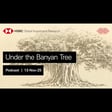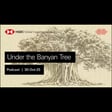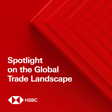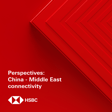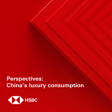Become a Creator today!Start creating today - Share your story with the world!
Start for free
00:00:00
00:00:01

Under the Banyan Tree - Fun facts from your friendly equity strategists
Herald van der Linde and Prerna Garg take the pulse of Asia's consumer, airline, autos and pharma sectors through the lens of our latest "Ten surprising statistics" report. Disclaimer: https://www.research.hsbc.com/R/101/lDDTdQb. Stay connected and access free to view reports and videos from HSBC Global Investment Research follow us on LinkedIn https://www.linkedin.com/feed/hashtag/hsbcresearch/or click here: https://www.gbm.hsbc.com/insights/global-research.
Transcript
Introduction to HSBC Global Viewpoint
00:00:01
Speaker
Welcome to HSBC Global Viewpoint, the podcast series that brings together business leaders and industry experts to explore the latest global insights, trends, and opportunities.
00:00:13
Speaker
Make sure you're subscribed to stay up to date with new episodes. Thanks for listening, and now onto today's show.
00:00:24
Speaker
This podcast was recorded for publication on the 27th of June by HSBC Global Investment Research. Analyst certifications, disclosures and disclaimers must be viewed on the link attached to your media player.
00:00:34
Speaker
And remember, you can follow us wherever you get your podcasts. Just search for Under the Banyan Tree.
Meet the Experts: Harold and Prerna
00:00:49
Speaker
Welcome to Under the Banyan Tree. I'm your host, Harold van der Linde in Hong Kong. With me in the studio is Prerna Garg, my fellow Asian equity strategist and co-author of our latest 10 Surprising Stats Report.
00:01:02
Speaker
We're going to be talking Elvish toys for adults, that's right, traffic jams, airline monopolies and much more. All by doing what we do best on the podcast, putting Asian markets and economics in context.
00:01:14
Speaker
Plenty of fun and fascinating facts to explore. Let's get the conversation started right here. Under the banyan tree.
Asian Toy Trends: Lalabu's Adult Appeal
00:01:31
Speaker
So Pruna, we got 10 stats. I don't want to go through all of them, but which one stood out for you? I know which one it was. You go. I think the stats we've been talking about for over two weeks now about the growing craze for Lalabu. Yes.
00:01:44
Speaker
ah So did you know that? Lalabu. Oh, Lalabu. Sorry. love so It's a puppet, right? It's... Let's not call it puppet. It will hurt many feelings, Harold, if we call it a puppet. It's actually an Elvis plush toy yeah ah manufactured by this listed company in mainland China called Pop Mart. The company is listed in Hong Kong.
00:02:03
Speaker
um But did you know that people queued up in London for up to five hours to get their hands on this so-called puppet puppet? Yeah, the Elvis plush toy that you just mentioned. That's right.
00:02:16
Speaker
And the crazy thing is that it's not 16-year-old girls who pop up. they're not. It's 40-year-old men that line up and and want to get this. The target audience is actually the people between the age group of 25 to 35.
00:02:31
Speaker
okay So yes, as you say, like, you know, probably the young adults. yeah And if you just walk down in Hong Kong, or you go to mainland China, Taipei, Seoul, you see like, you know, people have this monster character hanging on the side of their bag. It's crazy, right It's crazy. Like today morning, I saw this girl who had twinned her outfit with her Labubu outfit. Like, you know, so it's just not about buying the p plush toy, but it's just going more than that. So Labubu is going crazy.
00:02:59
Speaker
But what does this tell ah what what does this tell us? is what Why
China's Collectible Craze and Luxury Market
00:03:03
Speaker
is this happening? I think the two things that stand out to me, first of all, what is different is that the market for these plush toys, these collectibles have been growing for quite some time. But it was mostly the Japanese characters that gathered a lot of global attention. Yeah, you mean like Pokemon, Dorymon. Yeah.
00:03:20
Speaker
This is the first time, at least as per me, I see a Chinese company or a Chinese character getting so much of traction globally. That's true. I guess also what we see is that in China, consumption is coming back. Some of the retail sales, one month they're okay, another month they're a little bit weaker. But it seems like it's trying to move up. So people spending a bit more, but they're very careful. So we see...
00:03:44
Speaker
um yeah kind of, yeah, how we said this bit technical, but verticals, right? You see only particular pockets where people spend on. And this is a sort of affordable luxury. is that This is affordable. Like, you know, ah so we were talking about it. Is it another example of the so-called lipstick economy where people don't want to make big purchases, but they prefer to buy small ticket item things? That makes it feel good, right?
00:04:05
Speaker
But I wonder if it's just that, or do you think this is a consumer trend? Like, you know, this is a changing consumer trend that this is one industry which is genuinely going to be a multi-growth industry? Maybe, I don't know. I mean, at the moment for this company, there's an enormous amount of growth. I mean, we're not just talking about 15% growth. This company is growing hundreds and hundreds of percent.
00:04:25
Speaker
And it's going global as well. Before I stepped in ah for the recording, I happened to see how the stock price of the stock has done, Popmart, and the stock is up 15 times in last three years. yeah No, it's it's enormous.
00:04:39
Speaker
So it does tell us that people are very ah careful about spending but do want to spend. um ah It's also, as you say, it's a Chinese product that is going abroad. It's quite successful.
00:04:50
Speaker
um i I wonder if it's a fashion fad. ah Even two years' time, we find out that that 15 times up is going 15 times down. it's a structural growth story. Yeah, so we'll have to see this, right? So that's an interesting sort of How about you, Harold? Which is your favorite stats from these
Traffic Surprises: Congested Cities Revealed
00:05:05
Speaker
10?
00:05:05
Speaker
My favorite stat is ah something about traffic. So we travel around the region a lot, and therefore we get stuck in traffic a lot. So when I asked you some time ago, what do you think is the worst traffic? You said Jakarta. I actually think Jakarta has improved since the 90s, but that's a different story. If it's not Jakarta, we would think of like, know, one of the Indian cities. Exactly. Bangalore feels like. Mumbai, Kolkata. Mumbai, these sort of places. So we did a bit of research on it.
00:05:31
Speaker
Which city has the worst traffic? And there's different ways you can look at it. And it turns out in the top 10 cities in Asia, six of them are in India. Of course. And then Jakarta is in India, Manila, and a few other cities, is Bangkok. But?
00:05:44
Speaker
But this is the interesting thing. We then also looked at the amount of hours that people spent in a traffic jam. And then actually the rankings are suddenly different. Now, we don't have to go into the details there, but a Japanese city turns up. You would not expect that. Exactly. And I have to look at the name quickly, Kamamoto.
00:06:02
Speaker
Kamamoto. I never heard of Kamamoto. So you wonder the what... What makes Kamamoto so different? And we're talking about a country where the population is declining. Yeah, exactly. And traffic jams in, I mean, there are jams in Tokyo, but people that typically don't associate heavy traffic jams with Japan.
00:06:19
Speaker
Turns out Kamamoto is not a very large town. And this is the problem because next to it, TSMC has built a very large semiconductor fair. Wow, wow. So big that it needs thousands of people that work there. all now live in Kamamoto, but the roads can't digest it. So actually, TSMC has said, we're not going to slow it down.
00:06:39
Speaker
And the local government said, well, we'll try to build bridges and roads and and build infrastructure. So you can see how suddenly that changes the dynamics. And as per the stats, you have people on an average spend 150 hours in traffic every year in the city. Wow. That's basically, give or take, for normal people, about two three weeks of work. Yeah? Yeah, just at work. yeah And I think that that's the top. But if you go to Jakarta, I remember, it was 105 hours or something.
00:07:06
Speaker
Bangalore, also something ah around hours or so. But yeah, these are the cities you would expect. A Japanese city appearing to be the most the city with the most traffic, you would not expect. That's That's quite surprising. Now, I go back to you.
00:07:19
Speaker
You may pick a statistic now.
India's Airline Market: Indigo's Dominance
00:07:21
Speaker
I think I'll go back to my country. And like, you know, we're talking about the growing domestic consumption in India. We know like, you know, all the sectors are growing. But do you know that Indigo, which is an airline operator in India, they have near monopoly in 66% of its domestic routes? Yeah.
00:07:38
Speaker
Wait, so they, how many airlines are there? You've got, I mean, you've got a few. So there are three major airlines, Indigo, Air India, Spiset, and they're like, you know, a few small, one or two regional airlines. yeah But the airlines industry in India is highly concentrated and Indigo accounts for the major chunk of it.
00:07:55
Speaker
Yeah. So if you fly Delhi, Mumbai, there's everybody flies in that average, right? And ah Mumbai, Bangalore would be as well. But if you fly… Say Patna to Delhi, which is not ah very very… So you would probably just have one airline operating in that route and that would be Indigo. Indigo, yeah.
00:08:11
Speaker
So they must be quite profitable. See, it's ah not a full-fledged airline. So generally, the smaller airlines, low-carrier airlines tend to be profitable. But yeah Indigo in general um has ROE of 10%. They have net a margin of double digits. So yeah, they're quite profitable. So this is a highly profitable airline, which is a completely unusual thing in the airline industry. Most airliners struggle to make a bit of money.
00:08:37
Speaker
I think this tells a bit about India. like you know that in ah This is where I think there is a stark difference between the industry structure in India versus China. In China, we're talking about oversupply, a lot of and over ah competition and companies running off thin margin. In India, the competition in most of the sectors is not that intense. In fact...
00:08:58
Speaker
A lot of it is because of the government policies. Government tries to protect the industries, the ah FDI, the ah in order for a foreign company to set up a factory or a shop in India. They need like, you know, thousands of approval. So there's all these sort of entry barriers. There are a lot of entry barriers, but over years we see that there are some consumer sectors like, you know, FMCG, where the competition is gradually increasing.
00:09:22
Speaker
It's because more domestic or foreign players are slowly coming in. But I think this is one trend we have to monitor in India very closely that if the competition across various sectors increases, what does it do to the high profitability? Exactly. And I think we've seen this, for example, in Indonesia over for the last 15 years.
00:09:39
Speaker
So they've lowered the entry barriers and made it easy for people to come in. Infrastructure improved and competition improved. And in a sense, competition is good for consumers. It also forces companies to be innovative. That's the advantage China has.
00:09:51
Speaker
But in the immediate term, yeah, if you have less competition, you are more profitable, right? Right. Well, I suggest we take a quick break now. I'd like a cup of coffee, actually, as well. And ah then we'll we'll do each of us one more. Let's do that.
00:10:15
Speaker
So, Haral, one more stat. Which one do you pick?
Hyundai's Production Powerhouse
00:10:18
Speaker
um I pick one in Korea. So you've got Hyundai, or Hyundai, I think you have to pronounce it, that has one of the largest auto plants in the world, in Southeast Korea, in a town called Ulsan. It's not so far away from Busan.
00:10:34
Speaker
And there's like 30,000 people worked there. I believe I read it's like 5 million square meters in terms of size of the planet. That's incredibly big. So it's really big. And it's located straight on the river. So they literally they make cars and you then throw them onto a ship and there you go. You can ship them around the world.
00:10:52
Speaker
The thing is the status, they make a car every 14.4 seconds. So every 14.5 seconds, boom, a new Hyundai car. Wow. ah new haund de car So such stats often come out from Mail in China that like, you know, cattle is making one in these seconds. But it's it's quite interesting that even the Korean companies are doing so. And it's it's like, you know, you would expect that because Korean companies are also highly efficient and innovative. Yeah.
00:11:17
Speaker
And they have a global reach. So, yeah, it makes sense. But you wouldn't normally think about But, but like, you know, if you think about it, yes, they probably manufacture on an average every car in 14 and half seconds. But they don't really do that. It's more technical than that. i know So, in general, what happens is these companies, these manufacturing lines, produce cars in batches. So, in one batch, like, you know, a lot of cars are on an average. So, they make only a thousand, exactly, few thousand. So Hyundai actually manufactures 6,000 cars every day. And on an average, this means that it takes 14 and a half seconds for them to manufacture one car. Yeah, that's right. But it's still jaw-dropping. So already, while we've been talking, they've made 10 cars or something like that.
00:12:00
Speaker
Now, that was my last one. You you
China's Pharma Innovation
00:12:02
Speaker
can pick your last one. so So for me, it's about how, like, you know, we knew Chinese companies are known, China is known to be the factory of the world, but how China is picking up on innovation and especially in the pharma sector. So there's something called out licensing.
00:12:20
Speaker
What happens is a pharma company or a biopharma company has product, a patent they have on. um But in mainland China, specifically, the regulations on the pharma industry have been quite tight in the last few years.
00:12:32
Speaker
The hospitals, the pricing to hospitals, the caps on how much they can do. So Chinese companies, they are innovative. They're coming out with very exciting drugs like, you know, on cancer, heart, all the different complicated, complex medicines.
00:12:46
Speaker
But what they do is they give out the licenses to the foreign companies to use their medicine and then they charge them some fixed amount. So basically, they developed a drug. They tell, let's say, a German company, you can make it in Germany on your own. Here you go. You pay us somebody as a royalty.
00:13:03
Speaker
and There you go. And China was never really big into this. China was not. Like, you know, in ah Asia, generally in pharma sector, there were two countries which were big. One was India, yeah because Indian manufacturers known for manufacturing the generic drugs. Yeah, so they do it different, right? They take stuff that's coming off patents, typically from the US s and then they make it cheap. And they manufacture in India and then they export it.
00:13:24
Speaker
In Korea, a few companies in Korea do something similar. But here it's exact opposite. you You do the R&D, you create the patents and then you give the licenses to other companies to use your patents and you charge them in return. And I believe the stat is really that in 2017, it was only... china accounted for just 7% of such out-licensing revenues in the whole world. yeah And now it's as big as 30%. So over the last couple of years, they really emerged as an innovator yeah in the pharmaceutical drug industry. is it Interesting. Good.
00:13:55
Speaker
Now, that's how many stats were that?
Podcast Wrap-Up and Farewell
00:13:58
Speaker
Five or six? It doesn't matter. But there are at least um five other ones or six other ones yeah in the report. So anybody can pick it up and take a look at it. i must confess that, Harold, this is a one report we do every quarter. And I think this is one report I look forward to.
00:14:12
Speaker
Yeah, yeah, no, this is always fun because we're coming across so many numbers. An interesting way to tell, like, you know, the big trends that are emerging out of region. Yeah, because you can see the different trends in the region by just looking at one particular number. yeah And that brings us to the end of this week's podcast. A pleasure as always to have you with us.
00:14:28
Speaker
Under the Banyan Tree is an HSBC global investment research production and so is the Macro Brief, our sister podcast from London, which you should definitely subscribe to if you haven't done so already. Pruna, thank you again for coming.
00:14:40
Speaker
That's a wrap for today. Talk to you again very soon.
00:15:02
Speaker
Thank you for joining us at HSBC Global Viewpoint. We hope you enjoyed the discussion. Make sure you're subscribed to stay up to date with new episodes.

